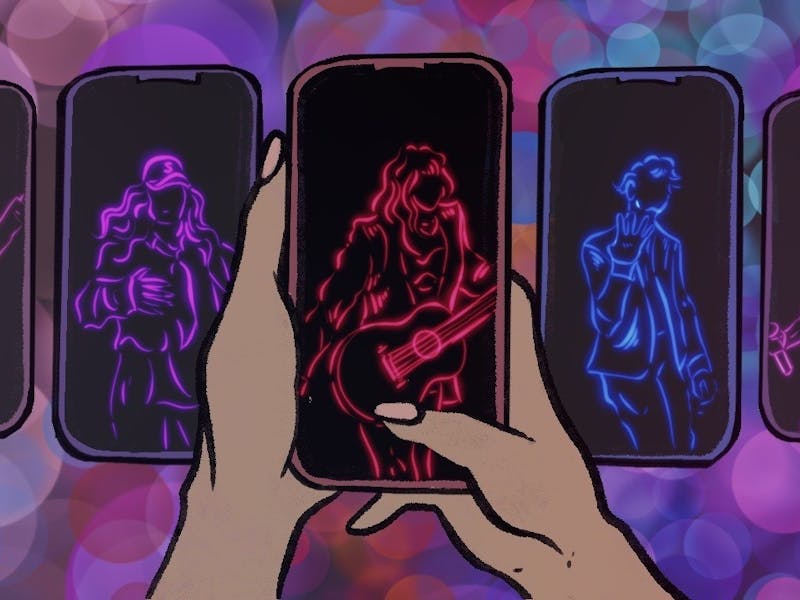Design by Emily Schoonover
Alexa, show me yesterday's memories
In the Black Mirror episode, “The Entire History of You,” people are implanted with grains that record everything the person sees, and stores these memories for playback. This ultimately ends up with a guy forcing his girlfriend to show him the memories of her cheating on him with their mutual friend, which is not even the most uncomfortable scene to watch. It may seem like this type of technology is light years away, but something very similar to it could be coming soon with technology from OpenWater, a Silicon Valley startup.
A few years back, Dr. Jack Gallant at UC Berkeley managed to create a program that could decipher what a person was seeing based off brain scans alone. Graduate students spent hundreds of hours under fMRI scans while watching movies to build a library for the program to reference when it came time for it to predict what the students were watching.
The result is trippy. This program was able to reconstruct the videos that students had watched while in the fMRI machine, almost shot for shot. If the student had been watching a video clip of a human, the program produced a very grainy image of a human. When presented with a clip of a plane descending, the program produced a large mass descending in the middle of the screen.
You can say that Dr. Gallant was able to read his students’ minds, but it is practically useless outside of experimentation if it requires hundreds of hours in an expensive machine the size of an entire room. If you have never needed an MRI, congratulations on your health, but if you had, you know just how massively uncomfortable it is to lie there with your head in a cage, listening to that god-awful noise. And because of the poor resolution of fMRI’s, the images produced were extremely out of focus.
However, tech from OpenWater could make a wearable imaging device, about the size of a child’s fingernail, akin to an MRI that could decipher our thoughts, effectively seeing – and possibly recording – everything that we see.
Founded by Dr. Mary Lou Jepson, OpenWater is on the mission to disrupt the current medical imaging system using a technique called holography, basically photography without a lens. It creates an image that allows you to see all of the light that gets transmitted through, passed through, or reflected off an object from every angle - all at the same time. This technique works because the human body is translucent, so near infrared light can penetrate the surface, even through bone, to a depth of about 6 inches - deep enough to pass through our skulls.
The system uses ultrasonic pings, near infrared light and Artificial Intelligence to visualize our internal systems. It could change the way we approach medical imaging because it does not utilize cancer-causing gamma or x-rays, it just uses red light. This has the potential to be very useful in detecting cancers, treating strokes and improving mental health, which are the main goals of OpenWater’s research.
Jepson was inspired to create a wearable medical imaging system after experiencing a crushing bout of sickness in graduate school that doctors could not figure out. She was going to drop out of school until one of her professors paid for her to get an MRI where her doctors discovered a brain tumor. This saved her life - and without that generous professor, she probably would have died. This is the reality for so many people who do not have the money to simply see a general practitioner, let alone get a MRI scan that can be several thousand dollars. Poverty is a death sentence for billions of people, yet Jepson was not living below, or even near the poverty line when she “went home to die.” The costs of medical imaging have gotten so astronomical that even the middle class cannot afford it, and every day we move toward a reality where if you are not rich, any sort of sickness can be a death sentence.
OpenWater plans to use the same infrastructure that makes your smartphone to manufacture this wearable imaging device so the cost will be similar to that of everyday consumer electronics instead being upwards of two grand for just 1 scan in an MRI. Their technology would also have a resolution of two thousandth of a millimeter, while an MRI only has a 1-3 mm reach. This could be the difference in catching cancer in stage one versus in stage four, and if you have a family history of cancer like I do, then this could easily save your life or the life of a loved one down the road.
But it doesn't stop there - OpenWater claims that this technology could also read our minds. Just imagine everyone being able to go home to their Cerebro machine and connect to people around the world like Professor X. Because blood absorbs near infrared light, this technology would be able to detect where blood is and where it isn’t. Most importantly, they will be able to tell if that blood is oxygenated or non-oxygenated, indicating activity in the brain. Because of the extreme resolution in this system, they would be able to focus down to individual neurons and measure their oxygen use. It would then scan the entire brain, forming a 3D map, or hologram, which a program would be able to analyze to decode what a person was thinking, feeling or seeing - similar to Dr. Jack Gallant but with more resolution.
This technology could go further and use ultrasonic pings to activate or inhibit neurons, essentially controlling our minds. When you think about it this way, this program seems more nefarious than life saving, but Jepson makes sure to point out that the system would only work with consent: you have to "think into it" in order for it to read your mind.
But once tech with such capabilities is out there, who's to say that it would require consent? We all know that Big Brother wants to be omniscient, Edward Snowden already proved that to us. So how do we know that they won’t get their hands on this, and turn it into something similar to the grains seen in “The Entire History of Us” and slip them into people’s brains?
At this point, we just have to wait and see. OpenWater has yet to reveal their system to the public, so it could be years before we start seriously having a conversation about chips the size of our fingernails being used to read and control our minds. The human body's translucency is the key, but to what doors it will open has yet to be determined.



